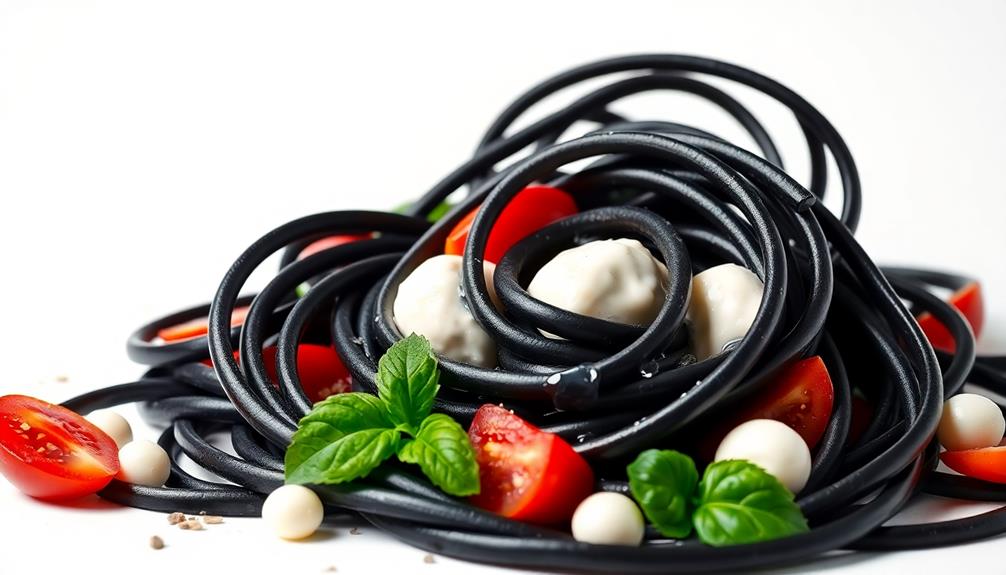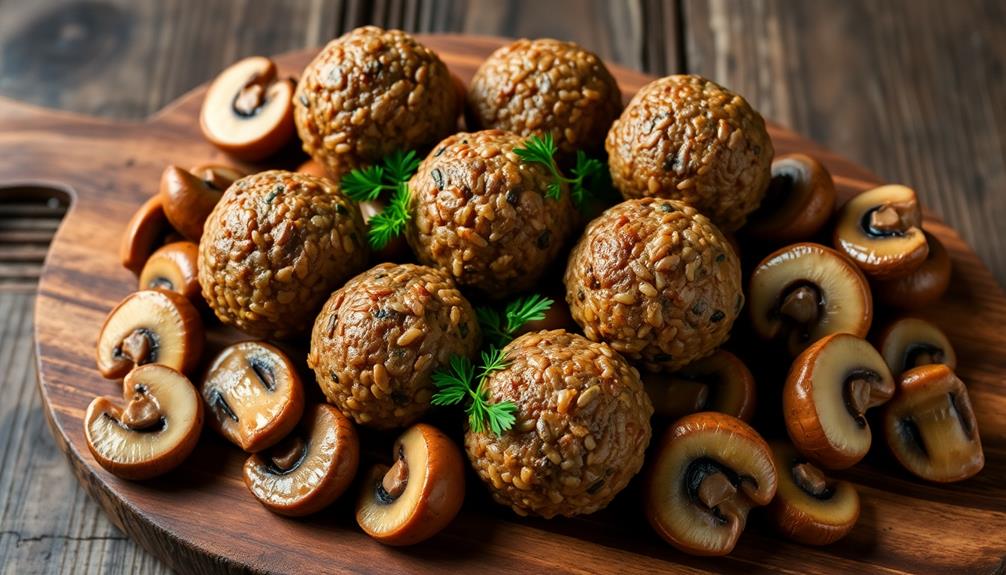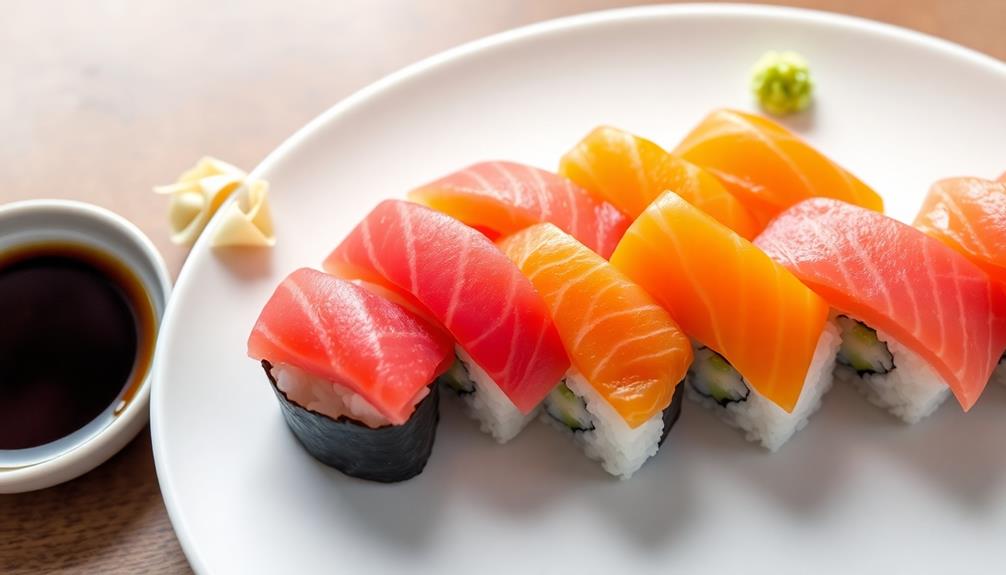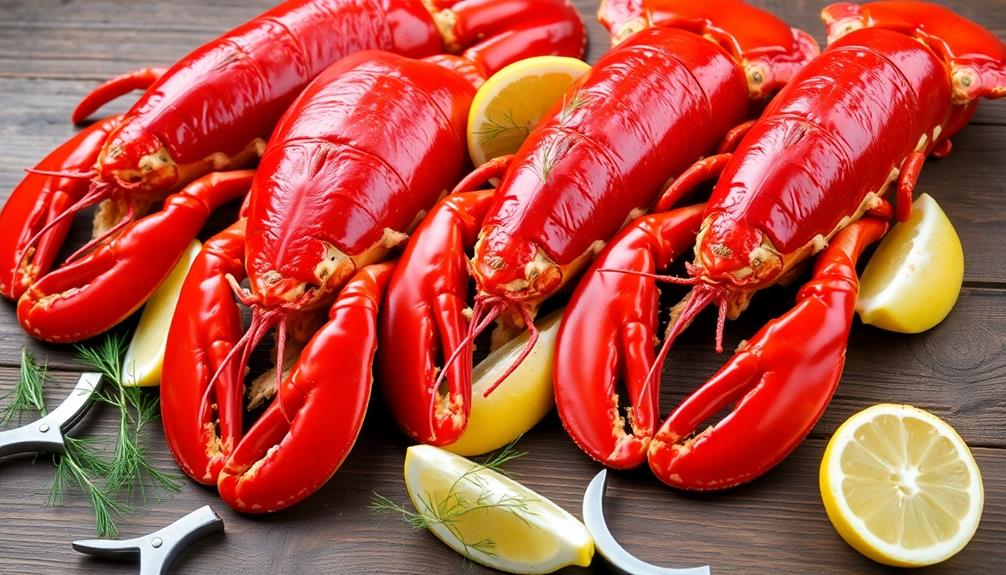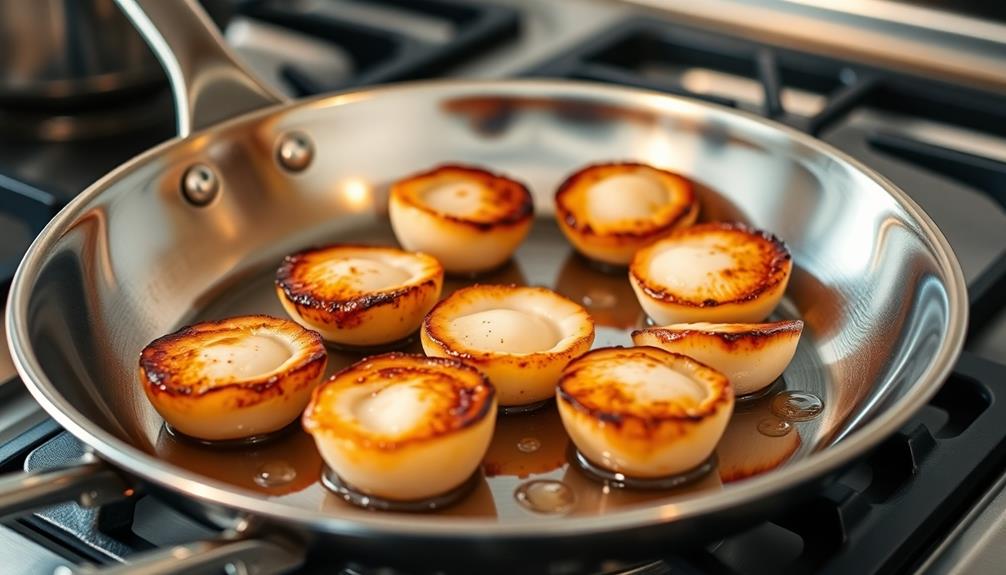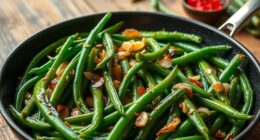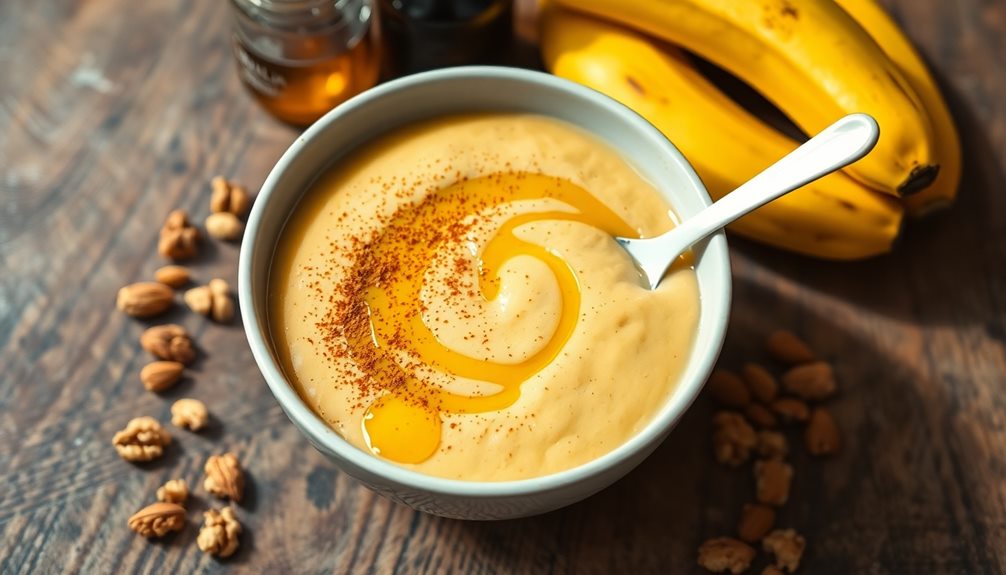Squid ink pasta captivates with its striking black hue and rich, briny flavor. Originating from coastal regions of Italy, this delightful dish has gained global popularity for its bold culinary flair. The squid ink lends a dramatic touch, complementing the delicate pasta perfectly. Prepare it with olive oil, garlic, shrimp, and Parmesan for a mouthwatering experience. The silky texture and savory notes elevate any meal, whether enjoyed as a main course or side dish. Squid ink pasta is a cherished addition to the culinary repertoire, encouraging exploration of new flavors and enhancing your cooking skills. There's more to discover about this captivating dish.
Key Takeaways
- Squid ink pasta is a cherished Italian specialty, known for its striking deep black color and rich, briny flavor that complements delicate pasta.
- Originating from coastal regions, squid ink pasta represents creativity and boldness in culinary experimentation, gaining global popularity as Italian cuisine spreads worldwide.
- The dish's visual appeal, with its inky black hue, creates a captivating culinary experience, while its flavor profile enhances the overall dish through complementary ingredients.
- Cooking techniques, such as reserving pasta cooking water and gently tossing the pasta, help achieve the desired texture and even distribution of the squid ink pigment.
- Squid ink pasta's versatility allows it to be served as a main course or side dish, suitable for both casual meals and formal dining, making it a versatile addition to any culinary repertoire.
History
When did squid ink pasta first emerge? You might be surprised to learn that this striking, black-hued pasta has been around for centuries!
It originated in the coastal regions of Italy, where people had easy access to the ocean's bounty. Cooks began experimenting with squid and cuttlefish ink, finding that it not only turned the pasta a dramatic color, but also added a savory, briny flavor.
Over time, squid ink pasta became a beloved specialty in places like Sicily and Naples. It was often served with simple, seafood-based sauces that complemented the pasta's unique taste.
As Italian cuisine spread around the world, squid ink pasta followed, captivating diners with its striking appearance and bold flavors.
Today, it's enjoyed by pasta lovers everywhere, who appreciate its ability to transform a simple dish into something truly extraordinary.
Whether you're new to this culinary delight or a seasoned fan, there's no denying the allure of squid ink pasta!
Recipe
Squid Ink Pasta is a visually stunning and flavorful dish that originated in the coastal regions of Italy. The deep black color of the pasta, derived from the natural pigment of squid ink, creates a striking contrast against the other ingredients. Typically served with seafood-based sauces, this pasta dish is a celebration of the sea's bounty.
The rich, briny taste of squid ink complements the delicate flavors of the pasta, making it a unique and memorable culinary experience. Whether served as a main course or as a side, Squid Ink Pasta is a true delight for the senses.
- 200g squid ink pasta
- 2 tablespoons olive oil
- 3 cloves garlic, minced
- 1 shallot, finely chopped
- 1 cup cherry tomatoes, halved
- 1/2 cup dry white wine
- 1 cup seafood or vegetable broth
- 200g peeled and deveined shrimp
- 2 tablespoons butter
- 1/4 cup grated Parmesan cheese
- Salt and freshly ground black pepper to taste
In a large skillet, heat the olive oil over medium heat. Add the garlic and shallot, and sauté until fragrant and softened, about 2-3 minutes.
Add the cherry tomatoes and cook for an additional 2-3 minutes, until they start to release their juices.
Deglaze the pan with the white wine, and let the mixture simmer for 2-3 minutes to allow the alcohol to evaporate. Add the seafood or vegetable broth and bring to a simmer.
Add the shrimp and cook until they're pink and opaque, approximately 3-5 minutes.
Finally, add the cooked squid ink pasta to the skillet, along with the butter and Parmesan cheese. Toss everything together until the pasta is evenly coated and the cheese has melted. Season with salt and pepper to taste.
When cooking squid ink pasta, it's important to follow the package instructions carefully to achieve the perfect al dente texture.
Additionally, be mindful of the intensity of the squid ink flavor, as it can be quite bold. Adjust the amount of squid ink pasta used based on personal preference.
Cooking Steps
Bring a large pot of water to a boil, then add a generous pinch of salt.
Once the water is boiling, stir in the squid ink until it's fully dissolved.
Carefully drop the pasta into the inky water and cook until al dente.
Drain the pasta, reserving a bit of the cooking water to toss with the noodles.
Step 1. Boil Water, Add Salt

To begin the cooking process, you'll first want to set a pot of water on the stove and bring it to a vigorous boil. Make sure to use a pot large enough to accommodate the pasta without overcrowding.
Once the water is at a rolling boil, it's time to add a generous pinch of salt. The salt not only enhances the flavor of the pasta, but it also helps the water come to a boil more quickly.
Cooking with ingredients like squid ink not only adds drama to your plate but also introduces unique flavors that can elevate your dish. Additionally, coffee's health benefits can add an exciting twist to your meal if you're considering creative pairings.
As the water is heating up, you can prepare the rest of your ingredients. Having everything ready to go will make the cooking process flow smoothly.
When the water is boiling furiously, go ahead and carefully add the squid ink pasta to the pot. Stir the pasta gently to prevent it from sticking together.
Cook the pasta according to the package instructions, testing it regularly to ensure it's cooked al dente. Drain the pasta, reserving a bit of the cooking water in case you need to thin out the sauce later.
Step 2. Add Squid Ink to Boiling Water

Once the water is at a rolling boil, you'll want to carefully pour in the squid ink.
Watch as the water transforms into an inky black broth, adding a dramatic flair to your pasta dish. The squid ink will quickly disperse, creating a bold, seafood-inspired flavor that will excite your taste buds.
As the pasta cooks in the inky water, it will absorb the intense color, resulting in noodles that are as visually striking as they're delicious.
The black hue of the pasta contrasts beautifully with any toppings or sauces you choose to pair it with, making for a truly stunning presentation.
Remember to stir the pasta occasionally to ensure even cooking and color distribution.
Once the noodles are al dente, drain them and toss with your desired sauce.
The dramatic black pasta will be the star of the show, sure to impress your family and friends.
Step 3. Add Pasta to Boiling Water

With the squid ink-infused water at a rolling boil, you can now carefully add the pasta.
Gently drop the noodles into the pot, making sure they're fully submerged. As the pasta cooks, it will release its starch, helping to thicken the inky liquid and give it an even deeper, more intense color.
Stir the pasta occasionally to prevent it from sticking together. The cooking time will depend on the type of pasta you're using, so be sure to follow the package instructions.
Generally, fresh pasta cooks faster than dried, so keep a close eye on it.
Once the pasta is al dente, meaning it still has a slight bite to it, it's ready to be drained.
Use a colander to carefully remove the noodles from the pot, letting the excess water drip back into the pan.
The squid ink-infused pasta is now ready to be tossed with your desired sauce and served immediately for a dramatic and flavorful dish.
Step 4. Drain Pasta, Reserving Cooking Water

The noodles are now cooked to al dente perfection. Carefully drain the pasta in a colander, reserving about a cup of the cooking water. This starchy liquid will be crucial for saucing your dish. Don't pour it down the drain – you'll need it soon!
With the pasta drained, transfer it back to the pot. The reserved cooking water will help the sauce cling to the noodles, creating a deliciously creamy texture. Gradually add a few splashes of the water, tossing the pasta to incorporate.
The starch in the liquid acts as an emulsifier, bringing the sauce together. Add more water as needed until you achieve your desired consistency.
This simple step ensures your squid ink pasta reaches its full flavor potential. The reserved cooking water is the secret ingredient that turns a good dish into a great one. Get ready to wow your guests with this restaurant-worthy pasta!
Step 5. Toss Pasta With Reserved Water
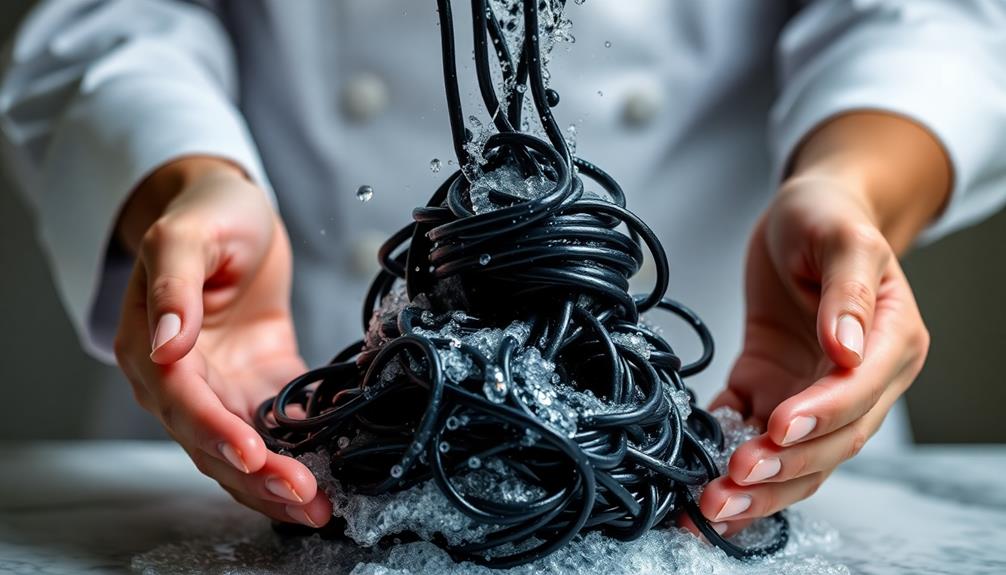
Tossing the al dente noodles with the reserved cooking water is a game-changer for your squid ink pasta dish. This simple step adds a silky, glossy finish that coats each strand, locking in the rich, briny flavor of the squid ink.
Don't drain all the water – you'll want to save a cup or two to work its magic. Gradually add the water, a little at a time, while gently tossing the pasta. The starchy liquid will emulsify, creating a creamy sauce that clings perfectly to your noodles.
This technique prevents the pasta from drying out and keeps it delightfully tender. The reserved cooking water also helps the squid ink pigment distribute evenly, ensuring each bite is dramatically inky black.
Toss with confidence, adding more water as needed, until you achieve your desired consistency. The result is a luxurious, velvety pasta that's ready to dazzle your guests.
Final Thoughts
Squid ink pasta, a captivating culinary delight, leaves a lasting impression on your palate. This striking dish not only tantalizes the senses with its dramatic black hue but also delivers a delightful savory flavor.
The unique inky color adds a touch of elegance and intrigue to any meal, making it a wonderful choice for special occasions or simply to add a bit of excitement to your everyday dining.
As you savor each bite, you'll be delighted by the silky texture and the subtle briny essence that perfectly complements the other ingredients. If you’re eager to experiment with this dish at home, consider incorporating different engastration techniques to elevate the flavors. Perhaps try wrapping the seafood in thin slices of prosciutto before roasting, or layering the ingredients with delicate, paper-thin sheets of phyllo dough for a crispy, textural contrast. The options are endless, and the results will surely impress your guests at your next dinner party.
Whether you choose to serve it with a creamy sauce, fresh seafood, or a simple garnish, squid ink pasta is sure to become a cherished addition to your culinary repertoire.
Embrace the bold and captivating nature of this remarkable pasta, and let it elevate your dining experience to new heights.
Frequently Asked Questions
Where Can I Buy Squid Ink for Making Pasta?
You can find squid ink at specialty food stores, Asian markets, or online retailers. Many grocery stores may also carry it in the seafood or specialty ingredients section. Check around to see where you can purchase squid ink for your pasta making needs.
How Long Does Homemade Squid Ink Pasta Last?
Homemade squid ink pasta will last 3-5 days in the fridge when stored properly in an airtight container. To extend its shelf life, you can freeze the pasta for up to 3 months.
Can I Use Regular Pasta Dough Instead of Squid Ink?
You can use regular pasta dough instead of squid ink, but the dish won't have the same dramatic black color or briny flavor. The texture and cooking time will be similar, but the overall taste and appearance will be different.
Is Squid Ink Pasta Gluten-Free?
No, squid ink pasta is not gluten-free. It's made with wheat flour, just like regular pasta. If you're looking for a gluten-free pasta option, you'll need to choose one made with alternative flours like rice, quinoa, or chickpea.
How Do I Store Leftover Squid Ink Pasta?
To store leftover squid ink pasta, place it in an airtight container and refrigerate for up to 3-4 days. When ready to eat, reheat the pasta gently on the stovetop or in the microwave, adding a splash of water if it's too dry.
